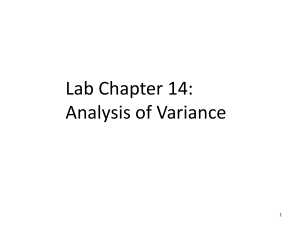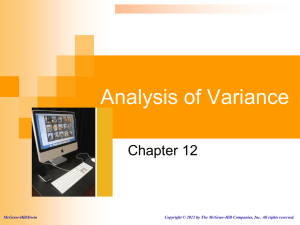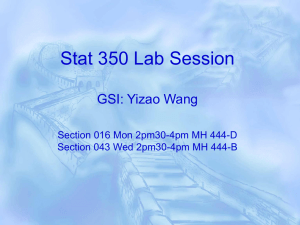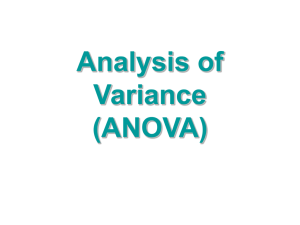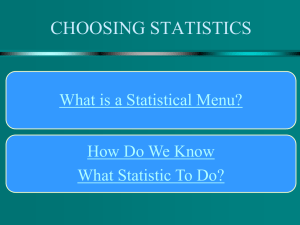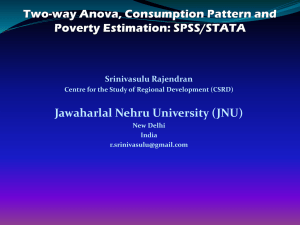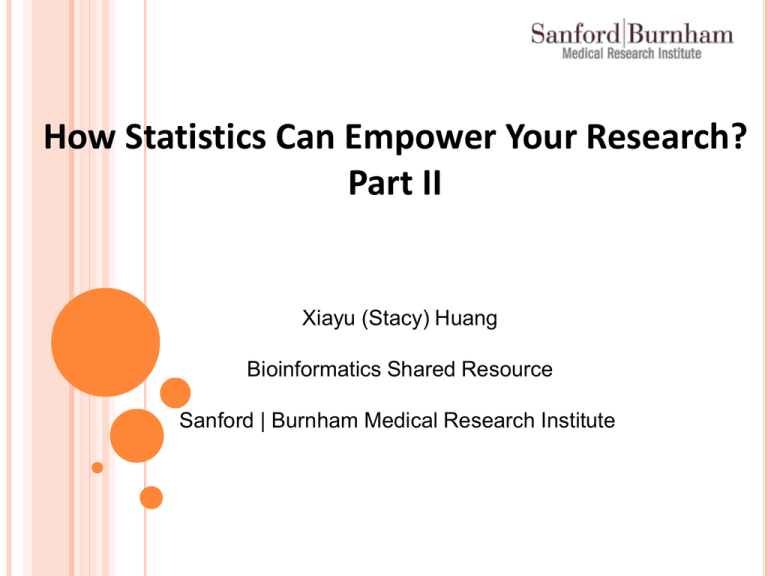
How Statistics Can Empower Your Research?
Part II
Xiayu (Stacy) Huang
Bioinformatics Shared Resource
Sanford | Burnham Medical Research Institute
OUTLINE
Summary of Previous Talk
Descriptive & inferential statistics
Student’s T test, one-way ANOVA
More common statistical tests and applications
Repeated measures one-way ANOVA
Two-way ANOVA
Power analysis
Common data transformation methods
SUMMARY OF PREVIOUS TALK
• Descriptive statistics
•
Measure of central tendency, dispersion, etc.
• Inferential statistics
• Hypothesis, errors, p-value, power
• Three statistical tests and their applications
•
Two sample unpaired test, paired t test and one way ANOVA
Power point presentation at http://bsrweb.burnham.org
ONE-WAY ANOVA EXAMPLE
• Goal:studying the effect of mice genotypes on their learning skills on rotarod.
• Dependent variable: number of seconds staying on a rotarod
Group1
Group2
Group3
Group4
170
116
30
114
214
102
60
24
122
120
136
72
44
82
126
42
80
90
56
20
130
54
6
32
DECISION TREE
DECISION TREE----ONE-WAY ANOVA
ASSUMPTION CHECK IN GRAPHPAD PRISM
DATA ANALYSIS IN GRAPHPAD PRISM
Variance check
REPEATED MEASURES ONE-WAY ANOVA
Compares the means of 3 or more groups
Repeated measurements on the same group of
subjects
Assumptions:
Sampling should be independent and randomized.
Equal sample size per group preferred.
Sphericity or homogeneity of covariance
Data is normally distributed.
APPLICATION OF REPEATED MEASURES ONE-WAY
ANOVA IN BIOLOGY
Days
REPEATED MEASURES ONE-WAY ANOVA EXAMPLE
• Goal:studying the effect of practice on maze learning for rats.
• independent variable : days
• dependent variable: number of errors made each day
Rat ID
Day 1
Day 2
Day 3
Day 4
Rat_1
3
1
0
0
Rat_1
Rat_2
Rat_3
Rat_2
3
2
2
1
Rat_3
6
3
1
2
DECISION TREE----ONE-WAY REPEATED ANOVA
TABLE FORMAT IN GRAPHPAD PRISM– REPEATED
MEASURES ONE-WAY ANOVA
DATA FORMAT AND CHOOSING ANALYSIS METHODS
DATA ANALYSIS IN GRAPHPAD PRISM
ANALYSIS RESULT
ONE-WAY REPEATED ANOVA COMPARED WITH
REGULAR ONE-WAY ANOVA
TWO-WAY ANOVA
One dependent variable and two independent
variables or factors
Assumptions
samples are normally or approximately normally distributed
The samples from each treatment group must be independent
The variances of the populations must be equal
equal sample size per treatment group preferred
Treatment group
all possible combinations of the two factors
Treatment
Gender
Placebo
Female
Drug
Male
Female
Male
TWO-WAY ANOVA
Main effect
Interaction effect
Effect of individual factor
Effect of one factor on the other
Hypotheses
The population means of the first factor A are equal
The population means of the second factor B are equal
There is no interaction between the two factors
Test
F test: mean square for each main effect and the interaction
effect divided by the within variance
MAIN EFFECTS
Pain score
• Asprin
•Ibuprophen
• Asprin
•Ibuprophen
A--Time
B
1st hr
2nd hr
A
I. No main effects for both time and treatment
1st hr
2nd hr
III. Main effect of time only
2nd hr
II. Main effect of treatment only
• Asprin
•Ibuprophen
• Asprin
•Ibuprophen
1st hr
B--Treatment
1st hr
2nd hr
IV. Main effects of time and treatment
MAIN EFFECT AND INTERACTION EFFECT
Pain score
• Asprin
•Ibuprophen
1st hr
2nd hr
V. Interaction effect only
• Asprin
•Ibuprophen
1st hr
VI. Main effect of time only and interaction effect
• Asprin
•Ibuprophen
1st hr
2nd hr
VII. Main effect of treatment only and interaction effect
2nd hr
• Asprin
•Ibuprophen
1st hr
2nd hr
VIII. Main effects of time and treatment, and interaction effect
TWO-WAY ANOVA EXPERIMENTAL DESIGN
I.
Control
Treated
Time 0
4
4
Time 2
4
Time 4
Time 8
Control
Treated
Time 0
3
4
4
Time 2
6
8
4
4
Time 4
3
4
4
4
Time 8
9
12
Balanced design with equal replication (Best)
Control
Treated
Time 0
1
1
Time 2
1
Time 4
Time 8
II.
Proportional design replication (Acceptable)
Control
Treated
Time 0
4
3
1
Time 2
2
2
1
1
Time 4
2
2
1
1
Time 8
3
4
III. One replication only (Not recommended)
IV. Disproportional design (Bad)
APPLICATION OF TWO-WAY ANOVA IN BIOLOGY
0 mM
50 mM
75 mM
Microarray: Time-dose relationship
TWO-WAY ANOVA WITH REPLICATION EXAMPLE
Study the effect of gender and anti-cancer drugs on tumor growth
Drug
cisplatin
Gender Female
Tumor
Size
vinblastine
5-fluorouracil
Male
Female
Male
Female
Male
65
50
70
45
55
35
70
55
65
60
65
40
60
80
60
85
70
35
60
65
70
65
55
55
60
70
65
70
55
35
55
75
60
70
60
40
60
75
60
80
50
45
50
65
50
60
50
40
DECISION TREE– FACTORIAL ANOVA
TABLE FORMAT IN PRISM—TWO-WAY ANOVA
DATA FORMAT AND CHOOSING ANALYSIS METHODS
CHOOSING MODEL
ANALYSIS RESULT
TWO-WAY REPEATED MEASURES ANOVA EXAMPLE
Goal: Investigating gender and caffeine consumption on the effect of memory
Independent variables: gender and caffeine consumptions
Dependent variable: memory score
Subject
Sex
Lowcaff
Medcaff
Highcaff
1
Male
10
15
17
2
Male
9
12
11
3
Male
11
14
15
4
Male
13
11
12
5
Male
11
10
16
6
Male
12
6
12
7
Female
10
14
14
8
Female
12
21
22
9
Female
21
18
23
10
Female
9
18
22
11
Female
12
16
20
12
Female
15
17
26
DECISION TREE----TWO-WAY REPEATED ANOVA
TABLE FORMAT– TWO-WAY REPEATED MEASURES ANOVA
DATA FORMAT AND ANALYSIS METHODS
CHOOSING MODEL
ANALYSIS RESULT
Matching not effective???
RECONSIDERING REGULAR TWO-WAY ANOVA
OUTLINE
Summary of Previous Talk
Descriptive & inferential statistics
Student’s T test, one-way ANOVA
More common Statistical tests and Applications
Repeated-measures one-way ANOVA
Two-way ANOVA
Power analysis
Common data transformation methods
POWER ANALYSIS
Power depends on:
Sample size (n )
Standard deviation ( or s )
Minimal detectable difference ( )
False positive rate ( )
effect size
Power analysis includes:
Sample size required
Effect size or Minimal detectable difference
Power of the test
POWER ANALYSIS SOFTWARE/PACKAGES
G*Power (free!!!)
Optimal design (free!!!)
SPSS sample power
PASS
SAS proc power, Stata sampsi, etc
Mplus for more advanced/complicated analysis
Many free on-line programs
http://www.stat.uiowa.edu/~rlenth/Power/
TWO INDEPENDENT SAMPLE POWER ANALYSIS
--INPUT AND OUTPUT PARAMETERS IN G*POWER
Sample size required
Input parameters
Effect size ( f )
False positive rate ( )
Minimum Power 1
( )
Ratio of two sample sizes
Output parameters
Noncentrality parameter ( )
Critical t
Degree of freedom
Sample size for each group
Total sample size
Actual power
TWO INDEPENDENT SAMPLES POWER ANALYSIS
--INPUT AND OUTPUT PARAMETERS IN G*POWER
Effect size
Input parameters
False positive rate
Minimum power
Sample size for each group
Output parameters
Noncentrality parameter
Critical t
Degree of freedom
Effect size
Minimal detectable difference
COMPUTE SAMPLE SIZE– TWO INDEPENDENT SAMPLES
DETERMINING EFFECT SIZE– TWO INDEPENDENT SAMPLES
ANALYSIS RESULTS– TWO INDEPENDENT SAMPLES
COMPUTE EFFECT SIZE– TWO INDEPENDENT SAMPLES
X-Y PLOT FOR A RANGE OF VALUES
FACTOR AFFECTING POWER—TWO INDEPENDENT SAMPLES
Power increases as total sample size increases
Power increases as effect size increases
Power increases as significance level increases
ONE-WAY ANOVA POWER ANALYSIS
--INPUT AND OUTPUT PARAMETERS IN G*POWER
Sample size required
Input parameters
Effect size ( f )
False positive rate ( )
Minimum Power 1
( )
Number of groups
Output parameters
Noncentrality parameter ( )
Critical F
Degree of freedom
Total sample size
Actual power
ONE-WAY ANOVA SAMPLE POWER ANALYSIS
--INPUT AND OUTPUT PARAMETERS IN G*POWER
Effect size
Input parameters
False positive rate
Minimum power
Total sample size
Number of groups
Output parameters
Noncentrality parameter
Critical F
Numerator and denominator degree of freedom
Effect size
Minimal detectable difference
COMPUTE SAMPLE SIZE-- ONE-WAY ANOVA
COMPUTE EFFECT SIZE– ONE-WAY ANOVA
FACTORS AFFECTING POWER—ONE-WAY ANOVA
Power increases as total sample size increases
Power increases as effect size increases
Power increases as significance level increases
OUTLINE
Summary of Previous Talk
Descriptive & inferential statistics
Student’s T test, one-way ANOVA
More common Statistical tests and Applications
Repeated-measures one-way ANOVA
Two-way ANOVA
Power analysis
Common data transformation methods
DATA TRANSFORMATION
Why?
Many biological variables do not follow normal
distribution
How?
Applying a mathematical function on each observation
Performing statistical tests using transformed data
Interpreting results using back transformation
Common data transformation methods in biology
Log transformation
Square root transformation
Arcsine transformation
Reciprocal transformation
LOG TRANSFORMATION
Usage
Convert a positively skewed distribution into a symmetrical
one
Applicable when there is heteroscedasticity and standard
deviations are proportional to the means
Mathematical function
x ' log2 ( x 1)
Logarithms in any base are satisfactory
x 2 ^ x ' 1
Back transformation:
SQUARE ROOT TRANSFORMATION
Usage
Applicable when the group variances are proportional to the
means
Samples taken from Poisson distribution such as counting data
Mathematical function
x ' x 0.5
Back transformation:
x x '^ 2 0.5
ARCSINE TRANSFORMATION
Usage
Applicable when data (proportions or percentages)
was taken from a binomial distribution
Mathematical function
p ' arcsin p
Back transformation:p (sin
p ') ^ 2
Shortcoming
Not good at the ends of the range (near 0 and 100%)
Adjustment needed when p near 0 and 100%
CHOOSING TRANSFORMATION BASED ON DATA DISTRIBUTION
Shape
Reverse J
Severe skew right
Moderate skew right
Figure
Transformation
A
B
C
1/X
Log (X)
sqrt (X)
CHOOSING TRANSFORMATION BASED ON DATA DISTRIBUTION
Shape
Moderate skew left
Severe skew left
J-shaped
Figure
D
E
F
Transformation
1/sqrt(X)
-1/Log (X)
-1/X
LOG TRANSFORMATION
Untransformed
Square-root
transformed
Log transformed
38
6.164
1.580
1
1.000
0.000
13
3.606
1.114
2
1.414
0.301
13
3.606
1.114
20
4.472
1.301
50
7.071
1.699
9
3.000
0.954
28
5.292
1.447
6
2.449
0.778
4
2.000
0.602
43
6.557
1.633
SUMMARY
ANOVA
One-way ANOVA
With or without repeated measures
Two-way ANOVA
Regular two-way ANOVA
Two-way repeated ANOVA
Power analysis
Two independent samples
One-way ANOVA
Data Transformations
Log transformation
Square root transformation
Arcsine transformation
BASIC STATISTICS TOOLS
Statistics software and packages:
1.Graphpad prism, SPSS and excel addins
2. G*power, Optimal design, etc
3. SAS, R, Stata, etc
Basic statistics books:
1. Intro Stats, SDSU, 2nd edition, Deveaux, Velleman, Bock
2. Choosing and Using Statistics: A Biologist's Guide
3. Biostatistical analysis, Jerrold H. Zar
4. Biostatistics: the bare essentials, Norman Streiner
5. Handbook of biological statistics
Thank You All for Coming!!!
Questions???


